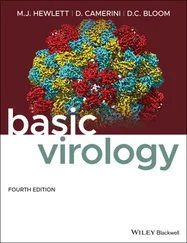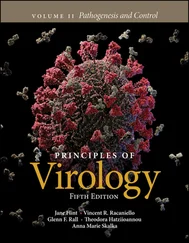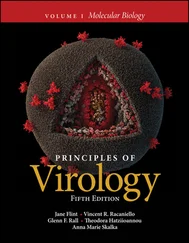Jane Flint - Principles of Virology
Здесь есть возможность читать онлайн «Jane Flint - Principles of Virology» — ознакомительный отрывок электронной книги совершенно бесплатно, а после прочтения отрывка купить полную версию. В некоторых случаях можно слушать аудио, скачать через торрент в формате fb2 и присутствует краткое содержание. Жанр: unrecognised, на английском языке. Описание произведения, (предисловие) а так же отзывы посетителей доступны на портале библиотеки ЛибКат.
- Название:Principles of Virology
- Автор:
- Жанр:
- Год:неизвестен
- ISBN:нет данных
- Рейтинг книги:3 / 5. Голосов: 1
-
Избранное:Добавить в избранное
- Отзывы:
-
Ваша оценка:
- 60
- 1
- 2
- 3
- 4
- 5
Principles of Virology: краткое содержание, описание и аннотация
Предлагаем к чтению аннотацию, описание, краткое содержание или предисловие (зависит от того, что написал сам автор книги «Principles of Virology»). Если вы не нашли необходимую информацию о книге — напишите в комментариях, мы постараемся отыскать её.
Volume I: Molecular Biology
Volume II: Pathogenesis and Control
Principles of Virology, Fifth Edition
Principles of Virology — читать онлайн ознакомительный отрывок
Ниже представлен текст книги, разбитый по страницам. Система сохранения места последней прочитанной страницы, позволяет с удобством читать онлайн бесплатно книгу «Principles of Virology», без необходимости каждый раз заново искать на чём Вы остановились. Поставьте закладку, и сможете в любой момент перейти на страницу, на которой закончили чтение.
Интервал:
Закладка:
In contrast to Moloney murine leukemia virus, other retroviruses, such as lentiviruses, canreproduce in nondividing cells. The preintegration complex of these viruses must therefore be transported through the nuclear pore by a mechanism that remains unclear. For human immunodeficiency virus type 1, increasing evidence suggests that CA-mediated attachment of the preintegration complex to NUPs is required for nuclear import. NUP engagement appears flexible, and several other capsid-interacting proteins affect the use of particular NUPs. At least some capsid proteins are transported into the nucleus with the preintegration complex, and their interaction with nuclear proteins influences integration site selection (see Chapter 10).
Perspectives
As the Trojans brought the vehicle of their destruction into their city, so do cellular processes bring viral particles inside the cell. Although the initial encounter between a single virus particle and a cell is random, viral proteins often exploit specific cell surface molecules to secure specific docking to their target cells. A diverse set of cell surface molecules are found to serve as viral receptors. On the other hand, the same molecule or molecules belonging to the same family of proteins can serve as receptors for divergent viruses.
Receptor binding is but the first step, and often initiates major conformational changes in the virus particles. For enveloped viruses, such conformational changes in the envelope glycoprotein eventually drive the fusion of viral and cellular membranes. For nonenveloped viruses, conformational changes generally lead to disruption of the cellular membrane and the delivery of a subviral complex to the cell interior. In both cases, these changes ultimately allow the viral genome to access a cellular compartment that enables replication. Although the mechanisms of entry for the various virus families appear vastly different, certain themes repeatedly emerge. Structural rearrangements in viral proteins that enable entry are often dependent on proteolytic cleavage events that occur either during assembly in the virus-producing cell or at the surface or within endosomal compartments during entry into the target cell. The acid pH found in endosomes is a common trigger for conformational rearrangements that enable entry. Such conformational changes almost always result in the exposure of hydrophobic protein sequences that can interact with and disrupt cellular membranes and allow access to the cell interior.
The cell is often not an idle target but an active participant in viral entry. Engagement of cell surface receptors by virus particles can trigger signal transduction pathways that lead to cytoskeletal rearrangement and endocytosis. Virus particle transport within the cell can be within vesicles, whose transport mechanisms are quite well understood. Conversely, vesicle-independent transport of viral or subviral particles on the cytoskeletal network is less well characterized. Notably, entry of various components of virus particles, nucleic acids and proteins, into the interior of the cell can be detected by specialized sensors that alert the innate immune system and elicit antiviral responses (a topic covered in Volume II, Chapter 3).
For some viruses, the final destination, and the site of genome replication, is the cell’s nucleus. The nuclear envelope raises an additional barrier to virus entry, with a plethora of proteins regulating access to the nuclear interior through the nuclear pores. Virus particles or subviral structures are too large to pass through the nuclear pore. Therefore, interactions with the specialized nuclear transport machinery are usually necessary for subviral structures to be escorted into the nuclear interior. This process is not well understood for many viruses.
Many questions about specific steps in the entry pathways of many viruses remain, including the elucidation of entry pathways used in whole organisms, a technically challenging endeavor. Understanding how entry proceeds and how particles “disassemble” to release the viral genome at the site of replication will allow us not only to develop specific interventions for prevention of virus infections but also to manipulate virus particles for use as viral vectors.
REFERENCES
Books
Pohlmann S, Simmons G.2013. Viral Entry into Host Cells . Landes Bioscience, Austin, TX.
Reviews
Cosset F-L, Lavillette D.2011. Cell entry of enveloped viruses. Adv Genet 73:121–183.
Fay N, Panté N.2015. Old foes, new understandings: nuclear entry of small non-enveloped DNA viruses. Curr Opin Virol 12:59–65.
Grove J, Marsh M.2011. The cell biology of receptor-mediated virus entry. J Cell Biol 195:1071–1082.
Harrison SC.2015. Viral membrane fusion. Virology 479-480:498–507.
Moyer CL, Nemerow GR.2011. Viral weapons of membrane destruction: variable modes of membrane penetration by non-enveloped viruses. Curr Opin Virol 1:44–49.
Papers of Special Interest
Bullough PA, Hughson FM, Skehel JJ, Wiley DC.1994. Structure of influenza haemagglutinin at the pH of membrane fusion. Nature 371:37–43.
Wilson IA, Skehel JJ, Wiley DC.1981. Structure of the haemagglutinin membrane glycoprotein of influenza virus at 3 A resolution. Nature 289:366–373.
These two seminal papers were the first to report the structure of a viral fusion protein, influenza HA. These studies established the foundation of models for the conformational changes occurring in viral proteins during fusion.
Butan C, Filman DJ, Hogle JM.2014. Cryo-electron microscopy reconstruction shows poliovirus 135S particles poised for membrane interaction and RNA release. J Virol 88:1758–1770.
This study shows the structural changes occurring in the poliovirus capsid shell during entry.
Carette JE, Raaben M, Wong AC, Herbert AS, Obernosterer G, Mulherkar N, Kuehne AI, Kranzusch PJ, Griffin AM, Ruthel G, Dal Cin P, Dye JM, Whelan SP, Chandran K, Brummelkamp TR.2011. Ebola virus entry requires the cholesterol transporter Niemann-Pick C1. Nature 477:340–343.
This paper first identified the receptor for ebolavirus.
Conley MJ, McElwee M, Azmi L, Gabrielsen M, Byron O, Goodfellow IG, Bhella D.2019. Calicivirus VP2 forms a portal-like assembly following receptor engagement. Nature 565:377–381.
This paper shows the formation of a pore in the capsid shell of caliciviruses that would allow the delivery of the (+) strand RNA genome to the cytoplasm.
Harutyunyan S, Kumar M, Sedivy A, Subirats X, Kowalski H, Köhler G, Blaas D.2013. Viral uncoating is directional: exit of the genomic RNA in a common cold virus starts with the poly-(A) tail at the 3′-end. PloS Pathog 9:e1003270.
This study challenged the idea that the viral RNA 5′ end is first to exit the capsid during entry of all picornaviruses.
Kane M, Rebensburg SV, Takata MA, Zang TM, Tamashita M, Kvaratskhelia M, Bieniasz PD.2018. Nuclear pore heterogeneity influences HIV-1 infection and the antiviral activity of MX2. Elife 7:e35738.
This paper examines the intertwined role of nucleoporins in HIV-1 nuclear import.
Читать дальшеИнтервал:
Закладка:
Похожие книги на «Principles of Virology»
Представляем Вашему вниманию похожие книги на «Principles of Virology» списком для выбора. Мы отобрали схожую по названию и смыслу литературу в надежде предоставить читателям больше вариантов отыскать новые, интересные, ещё непрочитанные произведения.
Обсуждение, отзывы о книге «Principles of Virology» и просто собственные мнения читателей. Оставьте ваши комментарии, напишите, что Вы думаете о произведении, его смысле или главных героях. Укажите что конкретно понравилось, а что нет, и почему Вы так считаете.











